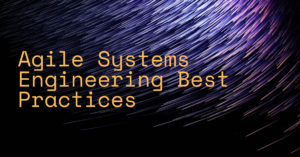
Agile Systems Engineering is a contemporary method for creating and delivering designed systems that can adapt to fluctuating market requirements and customer needs.
The sequential and plan-driven development procedure favored by conventional systems engineering is no longer enough in today’s dynamic business climate. Agile Systems Engineering, on the other hand, offers a flexible and adaptive strategy that promotes customer happiness, cooperation, and continual improvement.
This post is geared for seasoned engineers interested in introducing Agile Systems Engineering methods to their companies, and it will discuss some of the best ways to do it.
Understanding Agile Systems Engineering
Scrum, Kanban, and Lean are just a few of the Agile approaches that Agile Systems Engineering uses as its foundation. There are a few guiding concepts in Agile Systems Engineering, and they are as follows:
- Cross-functional teams and collaboration: Agile Systems Engineering places an emphasis on interdisciplinary teams comprised of professionals from areas as varied as engineering, product management, and customer service.
- Customer-centric approach: Agile Systems Engineering takes a customer-centric approach, putting the needs of the customer first by emphasizing their input and concentrating on providing them with value at regular intervals through releases and revisions.
- Iterative and incremental development: Agile Systems Engineering is an iterative and incremental development approach, breaking down large systems into smaller, more manageable chunks and delivering them in stages so that continuous feedback and alterations may be made based on the needs of the client.
- Continuous improvement and feedback loops: Agile Systems Engineering uses a continuous improvement frame of mind and utilizes stakeholder feedback to fine-tune both the product and the process.
Agile Practices for Systems Engineering
- Cross-functional teams and collaboration
In order to get the best results, Agile Systems Engineering stresses the value of interdisciplinary teams and group effort across departments and specializations. This calls for a mental and cultural transformation away from departments working in isolation and toward a common knowledge of what the product and the consumer want.
- Customer-centric approach
Agile Systems Engineering places a premium on hearing from and responding to its customers, and emphasizes continuous delivery of value. To do so successfully, one must have an in-depth familiarity with the consumer and their expectations, as well as the flexibility to accept and adjust to new conditions as they arise.
- Iterative and incremental development
The goal of Agile Systems Engineering is to provide complex systems in smaller, more manageable chunks over time, while incorporating regular customer input and iterative improvements. This method not only improves product quality but also shortens development cycles and time to market.
- Continuous improvement and feedback loops
Using input from all relevant parties, Agile Systems Engineering strives to refine both the product and the development process over time. To achieve this goal, one must use a data-driven approach and be open to trying new things and tweaking old ones.
Implementing Agile Development
- Choosing the right Agile methodology
There are several Agile methodologies to choose from, including Scrum, Kanban, and Lean. The right methodology will depend on the specific needs of your organization and the nature of the product you are developing.
- Defining roles and responsibilities
To be successful, Agile Systems Engineering teams need to have a common knowledge of the product and the customer’s wants and requirements, as well as well-defined roles and responsibilities. This will make sure that everybody is on the same page and working towards the same objectives.
- Establishing Agile systems engineering processes
To be successful in Agile Systems Engineering, one must have a firm grasp on the procedures and methods involved, as well as a hunger for improvement and the ability to roll with the punches as new needs arise.
- Adopting Agile tools and techniques
Agile Systems Engineering requires the adoption of appropriate tools and techniques to support the iterative and incremental development process. This includes tools for project management, collaboration, continuous integration and deployment, and customer feedback.
For an engineering tool that allows you to implement agile practices, look no further than Valispace.
- Building a culture of continuous improvement
Agile Systems Engineering requires a culture of continuous improvement, where feedback is valued, experiments are encouraged, and failures are seen as opportunities to learn and grow. This requires a shift in mindset and a willingness to embrace change.
Valispace for Agile Systems Engineering
Valispace is a cloud-based solution for supporting Agile hardware development.
It enables teams to save and share designs, requirements, and system models and link them in real time. This can assist in ensuring that everyone is on the same page and aid in the early detection of faults and discrepancies.
For most hardware engineering projects that want to go agile, the most helpful unique feature relates to the ability to connect requirements to engineering data.
This feature allows teams to ensure that all requirements are linked to engineering values and that any numerical data can be read and analyzed as such, rather than as flat text data.
This means that if any changes are made to your system, Valispace can automatically calculate whether this violates any of your project requirements.
Less work for your engineers, smarter insights for your project managers, and happier customers that love your product.
Another critical aspect of Valispace is its support for various agile development techniques such as Scrum and Kanban. This implies that teams may select the method that best meets their needs and adapt and adjust as necessary.
Valispace also offers a variety of additional features and tools that can aid with Agile hardware development including:
- Version control
- Communication tools
- Reporting and analytics.
Valispace can assist teams in managing complexity, collaborating efficiently, and delivering a great product by providing a comprehensive collection of tools and functionalities.
If you’re interested in adopting Valispace for your Agile hardware development project, schedule a call with the Valispace team to discuss your unique requirements.

